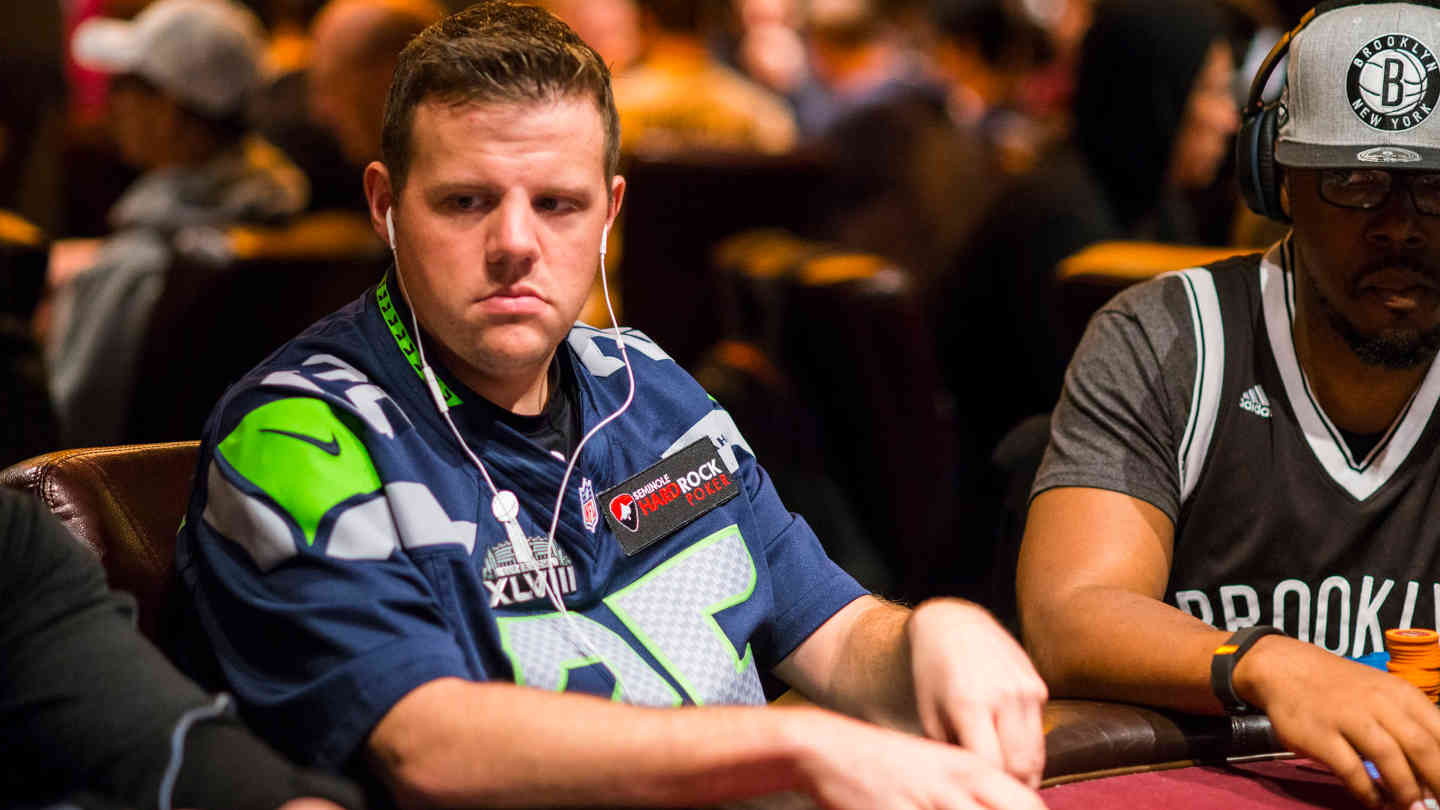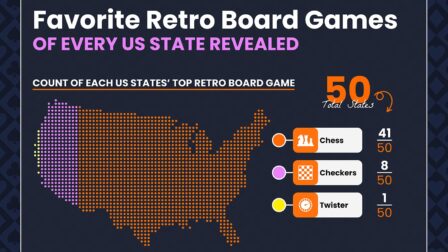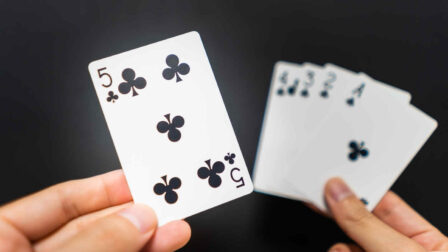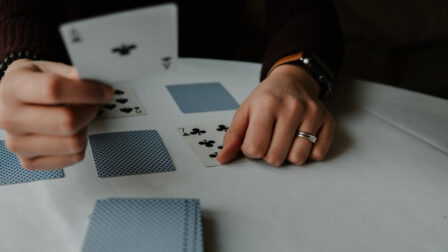Bridge Rules – Learn How To Play This Epic Card Game
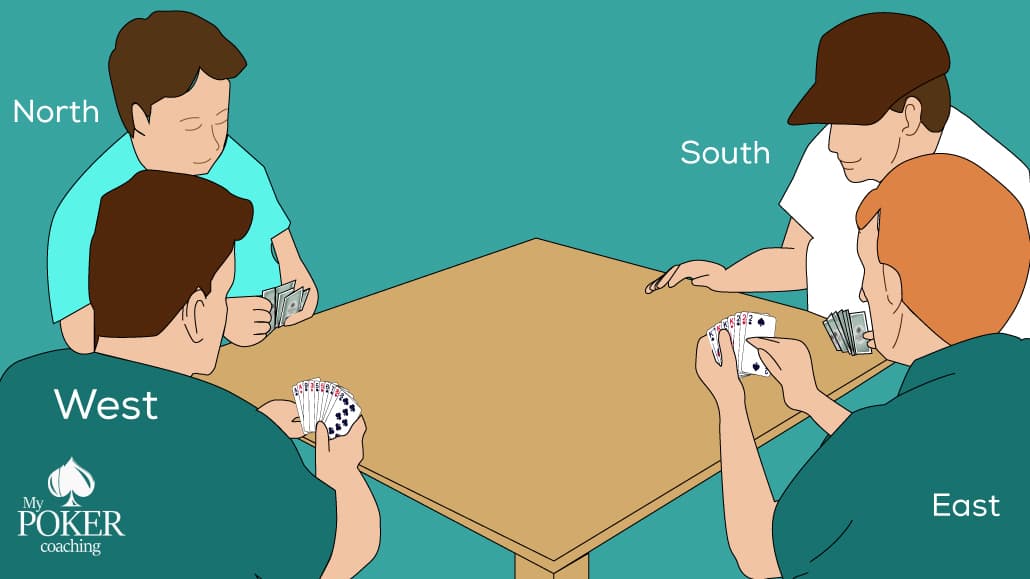
12 minutes
Last Updated: March 19, 2024
Of all the games played with cards, the bridge is easily the most complex one you'll encounter. Although the basic bridge rules aren't that hard to learn, the various strategies and conventions you'll need to memorize make things quite complicated.
When played in the tournament format, the bridge card game is almost entirely the game of skill, even more so than Texas Holdem.
The game is all about your ability to communicate the information to your partner and play your hand in the best way possible based on the information you have.
If you have some experience with tricks’ games, you’ll have a good starting point at least, as you’ll understand some of the fundamental premises of the bridge card game.
If you’re really intent on learning how to play bridge, you need to be prepared to put in some serious hours of studying. Unlike most other games like rummy, the bridge doesn’t make any sense if you try to play it “randomly.”
In this article, you’ll learn bridge rules and some fundamental concepts of the game, which should give you a nice head start on your journey. You won’t be ready to sit down and play immediately, but you’ll at least have a good idea of where to go next.
Bridge Glossary
- Bidding – the process of making a contract in bridge game, determining the goal that the partnership wants to achieve.
- Tricks – batches of four cards played face up. The number of tricks won determines if the contract is completed.
- Declarer – the player trying to make the contract.
- Defenders – players trying to prevent the declarer from making their contract.
- Dummy – declarer partner’s hand that’s placed face-up on the table after the bidding and before the play starts.
- Trump suit – the suit that’s been selected as the trump through the bidding process.
- NT – no-trump. A special kind of contract in bridge, where there is no trump suit.
- Game – a bridge contract of at least 3NT or 4 of any suit
- Small slam – a contract at the 6 level (like 6NT or 6c)
- Grand slam – a contract at the 7 level (like 7h or 7d)
- Conventions – special bidding systems used to exchange information between partners without actually talking.
Bridge Game Preparation
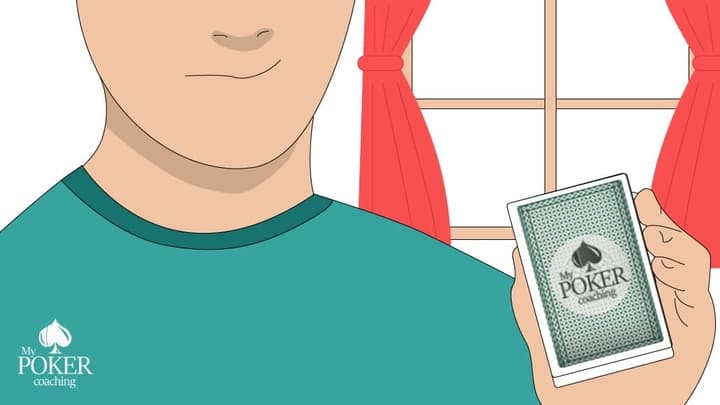
As far as logistics are concerned, the bridge card game isn’t particularly demanding. All you’ll need is a standard deck of cards and three more players.
The game is traditionally played by four players and in pairs or partnerships. Players sitting across each other are partners and are designated by four sides of the world.
- North-South (N-S)
- East-West (E-W)
While learning how to play bridge, it’s also a good idea to have a handy bridge scoring card.
You can find these online, but they are also often included in the decks. You’ve probably seen these before but didn’t know what they were for.
When playing in an official bridge tournament, you’ll also come across bidding cards. These are used for the bidding process, but you don’t need them when playing with friends. You can verbally announce your bids.
Bridge Rules
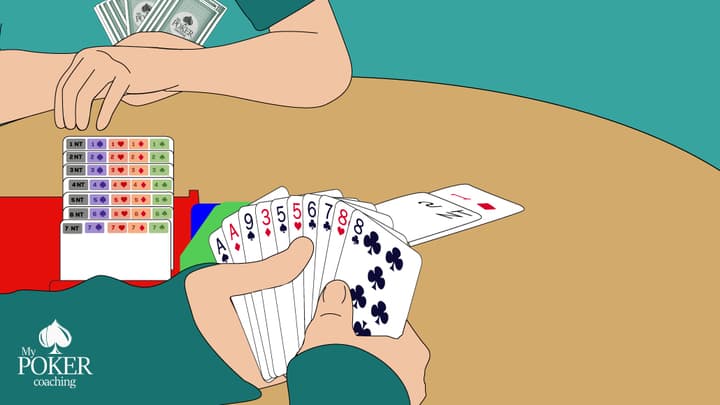
For most people, it will take some time to learn and understand bridge rules fully. The game is quite complicated, but you shouldn’t let this discourage you though.
Give yourself enough time and learn at your own pace.
The Objective of the Bridge Game
Your main objective in the bridge game is to either make the contract that you declared or prevent the other partnership from making the contract.
The side trying to make the contract is known as the declarers, and the other partnership takes on the defenders' role.
To make your contract, you'll need to win tricks through a process similar to that found in the game of spades. But, how do you arrive at the contract in the first place?
Bidding in Bridge: Making the Contract
In the bridge game, the bidding process is probably the most important and the most difficult part. You’re trying to achieve the highest number of points possible between you and your partner, but avoid going too high as failing to complete the contract comes with penalties.
In the simplest of terms, the contract defines the trump suit and the number of tricks you promise to win.
There are three main types of contracts in the bridge card game:
- Minor suit contracts: where clubs or diamonds are trumps
- Major suits: where hearts and spades are trumps
- Non-trump (NT): there are no trumps
But how do you go about making a contract?
It happens through the process of bidding.
It starts with the dealer, who can put in the initial bid of their choosing, or decide to pass, allowing the next player to make a bid (or pass), etc.
An individual bid promises to win six tricks plus whatever the number is mentioned in the bid.
For example, the dealer could start with the bid of one heart (1h). This means they're going for a contract of at least seven tricks (6 + 1), with hearts as the trump suit.
The player left to the dealer can elect to pass or bid themselves. If they want to bid, the bid has to be higher than the original bid.
In this particular example, the bid could be one spade (1s) or any bid on the second level (2c, 2d, 2h, 2s).
When making the bid on the same level, you have to bid the higher suit. Unlike when playing poker hands, suits have a different value in bridge card game and are ranked as follows – clubs, diamonds, hearts, and spades (from the lowest to the highest).
To arrive at the final contract, two partners need to work together.
This is where bridge rules become tricky. Every bid you make sends a certain message to your partner, and based on that information, they'll decide their action.
If North bids 1H and West passes, what should South do? How do they best support their partner and arrive at the most favorable contract?
This is where various bridge game conventions come into play. These conventions explain what every particular bid means within that convention. I'll expand more on that concept a bit later in the article, although you need to know that this is a vast topic that countless books have been written on.
Scoring in Bridge
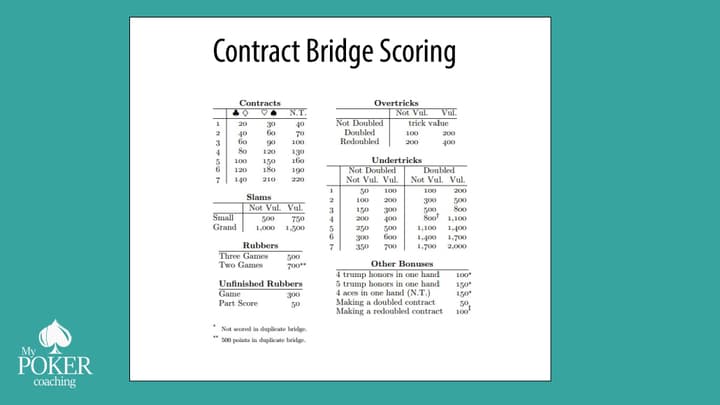
Much like the rest of the game, bridge rules for scoring are rather complicated. It will take you some time to memorize them, so you should probably print them out or have the scoring card around while still learning.
The number of points won in a round depends on the kind of contract declared and whether the declarers make the contract, fall short, or go over the promised number of tricks.
- Standard contracts: 50 points for making a contract + additional points for any over-tricks (+20 for a minor suit, and +30 for every major suit over-trick). If your contract is no trump, you’ll also receive additional +10 points.
- Bidding the game: bidding at level 4 for major suits (4h), at level 5 for minor suits (5c), and at level 3 for NT: +250 points if you make the game, plus all the points described above (basic contract and over-trumps).
- Small slam: making any contract at 6 level (like 6c or 6NT): +500 bonus points
- Grand slam: +1,000 bonus points.
If you fail to make your contract, you’ll receive -50 points for every under-trick.
For example, if you end up playing 3h but only make seven tricks, you'll be two tricks short and will receive -100 points.
During the bidding process, your opponents can also call doubles on your contract if they believe you can't make it. In that case, penalties for failing to make the contract are higher.
If you believe the other side is wrong and you’re confident you can make the contract, you can redouble, which gives you the chance to win extra points when you make the contract.
I won't explain the points' system for doubles and redoubles here in detail. When you're ready, you can easily find this information, but you won't need it when just starting with the bridge game.
Going for doubles is an advanced play that you can only make once you develop a better understanding of how the whole bidding process works and how to figure out if you have enough key cards between you and your partner to prevent the opponents from making the contract.
You should focus on learning basic bridge rules and how to play this game for the time being. When the time comes to expand on your knowledge, there are heaps of resources out there to help you.
Dealing Cards in Bridge
Everyone receives 13 cards, face-down, to start the round. Cards are dealt one at a time, starting with the player to the dealer’s left and moving clockwise.
How to Play the Bridge Card Game
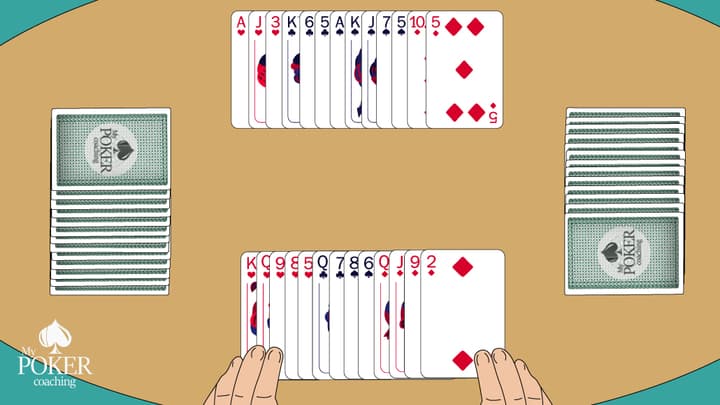
Learning how to play bridge once the bidding is done is actually the easier part. While there is still a lot of strategy involved if you want to play properly, at least the bridge rules for this part of the game are fairly straightforward.
Playing a Hand of Bridge
Once the bidding is done, you’ll know who’s the declarer and who’s defending. At the start of the play, the player's partner making the final bid will put their cards on the table, face-up, for everyone to see.
This is known as the “dummy” hand. Once cards are tabled, the partner no longer actively participates in the hand.
The player seated immediately left to the declarer (the still-active player from the declaring partnership) will play the first card, face-up, on the table.
The play then continues clockwise, so it's the dummy hand that goes next on the first play.
Since the declarer's partner is no longer participating in the hand, the declarer decides what cards they want to play from the dummy. So, the declarer plays both hands for the partnership.
The player who wins the trick is the next lead with any card from their hand, and the round plays according to the same rules.
Winning Tricks in Bridge
The first card to be played on the table is known as the lead. Once the lead is played, all players must follow suit, if possible.
So, if the player leads with an Ac, all players must also play a club, if they have any clubs in their hands.
The trick is won by the player playing the highest-ranking card of the corresponding suit (aces are high in bridge card game).
If a player can’t follow suit, they’re allowed to play any card from their hand. If it is a contract with a trump suit, this includes any trump cards. In the event one or more trump cards have been played, the trick is won by the player playing the highest-ranking trump card.
In no-trump (NT) contracts, there is no trump suit. This means that the trick is always won by the highest card in the lead suit.
Calculating Points
Once all 13 cards have been played, players will count tricks and mark down the scores. The scoring is done using the earlier described system. When all scores are noted, a new hand of the bridge card game can commence.
Bridge Game Tips & Tricks
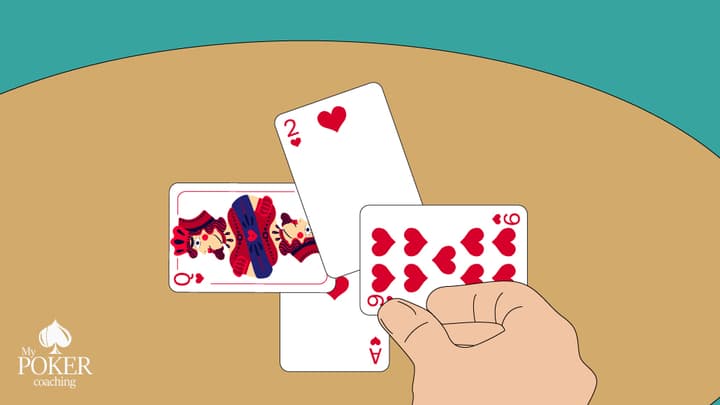
Learning bridge card game rules is one thing, but learning how to play bridge well and make no mistakes in the process is an entirely different matter.
Bridge strategies are so complex and detailed that it will take much more than reading a few tips to become good at it.
However, you should still try to understand these common notions, as they’ll help you on your journey to becoming a great bridge player.
Bridge Card Game Tip #1: What Are Conventions in Bridge?
If you remember, we've mentioned conventions earlier in this text. These are very specific bidding systems that help players communicate with each other without talking to their partner. In bridge, you're not allowed to talk to other players unless you're making a bid.
In official tournaments, special cards are used for this purpose, and players aren’t allowed to talk or exchange any signals at all. Any such behavior would be considered cheating.
There are well over two dozen bridge game conventions, and it's up to you and your partner to agree which one you want to use. You also need to let your opponents know what convention you're using, but it’s not your job to explain how it works. If they don’t know, that’s on them.
To give you an idea of how these conventions work, here’s an example of Acol, a fairly simple one quite popular with beginners.
In Standard Acol, your opening bid promises at least 12 high card points. High card points (HCP) are counted as follows:
- Aces: 4 points
- Kings: 3 points
- Queens: 2 points
- Jacks: 1 point
There are many special bids within this system. For example, when you open with the bid of two clubs (2c), you aren’t sending a message that you want to play in clubs.
Instead, you’re letting your partner know you have a strong hand (at least 23 HCP) and are inviting them to the game (going at least to level 4 or 3NT).
Based on your partner's response, you'll try to further determine what suit you want to play in or if you might be better at playing in NT.
This is just a very small fragment of how bridge game conventions work. Once you’re done learning bridge rules, I suggest you spend some time studying Standard Acol, as you’ll need to know at least one convention if you want to play the game correctly.
Bridge Card Game Tip #2: There Is No Shame in Passing
New bridge players often feel compelled to make a bid, especially when they’re the first to speak. There is really no shame in passing, though.
You should only open bidding if you have at least 12 HCP in your hand.
This is the bare minimum to start looking for a contract between you and your partner. If you have fewer points, simply pass and see what happens.
Enjoy All the Intricacies of the Bridge Card Game
If you feel like all these rules and conventions are too much to handle, don't worry. Learning how to play bridge is no easy task, and this isn't a card game you can learn in a few minutes.
Unless you happen to be very talented, you'll spend a long time feeling a bit lost while playing. That’s perfectly fine, though.
Bridge isn’t the war card game or anything in an alight with go fish. It’s a complex game that will test your skills and your memory to the max.
It may not be everyone’s cup of tea, but if you fall in love with it, bridge has a lot to offer.
There is always something new to learn. If you find a partner who's equally enthusiastic about it, you can have loads of fun playing and learning bridge card game.










